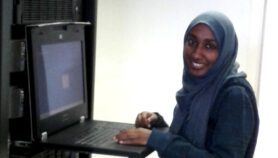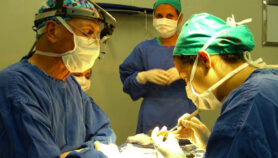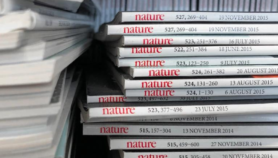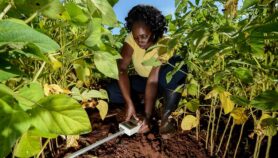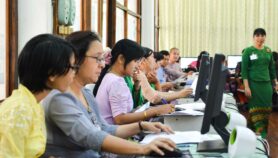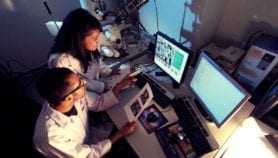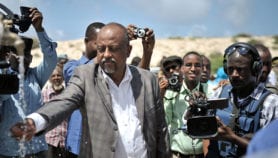Send to a friend
The details you provide on this page will not be used to send unsolicited email, and will not be sold to a 3rd party. See privacy policy.
Leslie Chan, Barbara Kirsop and Subbiah Arunachalam give a comprehensive background to the need for open access publishing.
The science base in the developing world cannot be strengthened without access to the global library of research information. Currently, this is nearly impossible due to the high costs of journal subscriptions, with the result that even the most prestigious institutes in poorer countries cannot afford to buy the journals they need.
Many initiatives have been started to resolve the access problem, but progress has been slow and, since they are generally dependent on grants or subsidies, are unlikely to be long-term solutions. With the advent of the Open Access (OA) initiative, the outlook for building science capacity in developing countries has improved significantly.
In particular, the establishment of interoperable open access archives that is now underway by a rapidly growing number of institutes opens opportunities for true global knowledge exchange. OA archives are described and progress in both developed and developing regions is recorded, concluding with recommendations of what remains to be done to achieve the goal of free access to all publicly funded research publications.
Introduction
Scientific progress in developing and emerging countries is greatly hampered by their inability to afford essential journals. [1] At the same time, research generated in these regions is ‘missing’ to the international knowledge base because of financial restrictions affecting its publication and distribution. [2, 3] Thus, there are both North to South and South to North knowledge gaps, leading to incomplete pictures of global science in general, and global health, environmental and development issues in particular. [4–6]
The development of the OA movement offers hope for information-deprived scientists. The landmark meeting initiated by the Open Society Institute in Budapest in 2001 resulted in the establishment of the Budapest Open Access Initiative and a definition of two primary ways of closing knowledge gaps in science.
The first OA strategy was called Self Archiving, and subsequently also referred to as Institutional Archives/Institutional Repositories, and proposed that copies of already published research articles should be archived in the author’s institutional archive and made available free to all. All such Open Access Archives (OAA) would be OAI-compatible (they would comply with the Open Archives Initiative’s Metadata Harvesting Protocol) and hence be interoperable and searchable by any search engine). The second strategy was the development of OA journals (OA Publishing) with alternative funding models that allowed free access to all readers with costs borne by the authors’ institutes or sponsoring organisations.
In this paper we detail the reasons why OA archiving provides the greatest and most immediate impact on science and development. We begin by outlining the key barriers to access to scientific knowledge in developing countries, and follow this by listing the demonstrated benefits of OAA and the progress that has been made in both developed and developing regions, and finally summarising how open access can transform the research scene from one of isolation and marginalisation, to one of inclusion and international cooperation.
Science and technology in developing countries — the current status
The close link between scientific development and the social and economic wellbeing of a nation has long been recognised. Jawaharlal Nehru, India’s first prime minister, said: "It is science alone that can solve the problems of hunger and poverty, of insanitation and illiteracy… Who indeed can ignore science today? We need it at every turn." [7] Likewise, a 1982 UNESCO report states that "assimilation of scientific and technological information is an essential precondition for progress in developing countries". [8] The InterAcademy Council says: "In a world moving rapidly toward the knowledge-based economies of the 21st century, capacity building in science and technology (S&T) is necessary everywhere. But the need is greatest for the developing countries." [9]
However, the capacity to absorb scientific and technical knowledge is often weak in developing countries, leading to low levels of scientific output and further under-development. [10] Science in less advanced countries is characterised by weak institutional infrastructures, poor funding, the absence of a critical mass of scientists to form a viable research community, the consequent isolation and insularity of a research community against which ideas can be exchanged, leading to a poor contribution to the world’s knowledge pool. [11,12]
Most new knowledge is largely reported from the richer countries, where spending on research and development is highest. [13, 14] In a recent study of the comparative performance of the world’s major science producing countries, King found that researchers in eight countries — led by the United States, the United Kingdom, Germany and Japan — produce almost 85 percent of the world’s most cited publications, while 163 other countries, mostly developing nations, account for less than 2.5 percent. [15] An example of this highly uneven output and citation is that only ten per cent of the global health research is undertaken in the developing world, and only two per cent of the 3,000 journals indexed on Medline are from developing countries. [16,17] About 80 per cent of the world’s population contributes only 13 per cent of the 140,000 titles listed in Ulrich’s Directory of Scientific Serials.
In efforts to contribute scientifically, developing countries need access to essential global research findings, particularly in the areas of health, agriculture and sustainable development. [6,9,14,18,19] However, researchers in these regions often have little or no access to the published research literature due to the high cost of journal subscriptions and inadequate and expensive distribution mechanisms. [20, 21] According to a recent survey conducted by the World Health Organization (WHO), in the 75 countries with an annual gross national product (GNP) per capita of less than US$1,000, some 56 per cent of medical institutions had no subscriptions to journals over the previous five years; in countries with a GNP between US$1,000 and US$3,000, 34 per cent had no subscriptions and a further 34 per cent had an average of two subscriptions per year. [22] Under these circumstances it is clear that progress in science and development in low-income countries can be made only with very great difficulty. As long as this asymmetry in research output and access to up-to-date information remains, research scientists in the developing world will remain isolated and their research will continue to have little impact.
While it is easy to imagine the consequences of the information famine on the scientific community in the countries so affected, it is seldom recognised that the international scientific community is similarly impoverished. Without the input of knowledge from the disadvantaged regions, development initiatives may suffer from inappropriate programmes. An example of this can be seen in the case of tuberculosis. It is now known that isolates of Mycobacterium tuberculosis from India differ genetically from those taken in the West, and are different again from those isolated in China, so the BCG vaccines developed in the West have reduced efficiency. [23] Similarly, it has been shown that in diabetes, what works in the United Kingdom might not work in India and vice versa, as environmental and genetic factors have been shown to play a part. [24,25]
However, increasing the visibility of research from the less developed countries is difficult. Publication in mainstream journals faces the problem of recorded prejudice against submissions from developing country scientists; [4,26,27] local journals struggle to survive and have very poor visibility due to the high costs of publication and distribution. [28,29] Few ‘local’ journals are indexed by the Science Citation Index, and those that are generally have low impact factors [30, 31] so that scientists in developing countries are understandably reluctant to publish locally.
Until the imbalance in access and distribution of scholarly literature is redressed, science in the developing world will continue to lag behind and, since global outbreaks of infectious diseases and climate catastrophes are increasing, societies in the developed world will continue to be affected adversely. [32]
What are open access archives?
Open Access Archives (OAAs) are electronic repositories that may include already-published articles (post-prints), pre-published articles (pre-prints), theses, manuals, teaching materials or other documents that the authors or their institutions wish to make publicly available without financial or other access barriers. [33] Our focus is on articles published in peer-reviewed journals, as they represent the main source of research results that largely remain kept behind subscription barriers.The primary goal of OAA is to maximise the accessibility of the research publications and their impact, as it is this that forms the basis for future scientific development.
The term ‘self archiving’ refers to the process whereby individual authors submit their own papers to a server or archive of their choice. ‘Institutional archives’, administered by universities or research institutes for members of their community, are the fastest growing form of open archives, although it was the subject based archives, such as the long-established ‘arXiv’ physics archive that created the initial momentum for the self-archiving and OA movement.
While there is ongoing debate about the strategic importance of institution-based versus subject-based or other centralised archives, there is a growing consensus that publicly funded research should be publicly available. This growing understanding that knowledge produced by publicly funded research is a global public good that needs to be shared is fuelling the current rapid growth of OAA. [34]
This growth is due also to the adoption of common technical standards defined by the Open Archive Initiative and common protocols for retrieving metadata, thus enabling distributed OAI-compliant archives to be searched seamlessly. The consequence of this is that the geographical location of a paper submitted to an OAI-compliant archive has no effect on the ability of search engines such as OAIster and Google to find it.
As of 10 August 2005, OAIster was harvesting some 5,788,896 records from more than 520 institutions around the world. Although this shows the power of the search engine, these figures include much more besides published scientific papers and not all of the indexed papers are provided in full text. However, records and their sources are clearly tagged and can readily be recovered using appropriate keywords. This is obviously of great benefit to authors in developing countries, since institutions in these regions with compliant open archive servers become part of the international community and their published research part of the global library of science. A search for ‘Plasmodium falciparum’, for example, now finds papers published not only in the British Medical Journal, but also in such journals as the Journal of Post Graduate Medicine (Mumbai, India), or Memórias do Instituto Oswaldo Cruz (Brazil).
The technical infrastructure for setting up institutional archives is now in place and the costs are minor. A variety of free open source software is readily available for setting them up. The best-known and most widely used software are Eprints made available by the University of Southampton, United Kingdom, and DSpace made available by the US-based Massachusetts Institute of Technology. Recent versions of both are easy to install. There is much other freely available software (see the Guide to Institutional Repository Software produced by the Open Society Institute).
Typical costs for setting up an institutional archive will need to cover those for a server (if one is not already available), computer staff time for setting up the archive and administering it, and library or other staff time in formatting and submitting documents. Precise costs will depend on what resources are already available and can be diverted to the process. India’s National Institute of Technology has set up an institutional archive, and its National Informatics Centre and the Indian Statistical Institute have set up central archives — OpenMED (for biomedical research) and LDL (Librarians in Digital Library).
The managers of all three archives are unanimous in their view that costs are indeed minor; the major expense is for the server and the Internet connection, which would be available to most higher educational institutions. Time required for document conversion and submission will depend on the number of documents processed and whether authors do this themselves or whether libraries or computer departments provide a centralised service. [35] Overall costs are likely to be low and will be more than repaid by increased visibility of the institution’s research output.
The benefits of OAAs
The benefits of OAAs to researchers and scientific organisations in developing countries are numerous. Among the advantages are the following:
(i) Access to international research output
Research that is currently inaccessible because of financial barriers becomes globally accessible. As more and more international institutes establish archives, a growing body of published research becomes available to anyone with Internet access.
(ii) International access to research generated in developing countries
Scientists in developing countries are under pressure to publish in foreign or ‘international’ journals with a notable ‘impact factor’ (as measured by ISI’s Science Citation Index) if they wish to be recognised within and outside their own countries. [36] However, the Science Citation Index includes very few ‘local’ journals, so scientists in developing countries prefer not to publish in them. As articles published in overseas journals are often inaccessible to other scientists in developing countries due to high access costs, many publications by developing country scientists remain invisible to scientists in their home countries. The result is that it is difficult for institutions and funding agencies in developing countries to take stock of their research output and for neighbouring countries to share their research. [20, 37]
Open access archives would be especially valuable to transitional economies such as Brazil, China, India and South Korea, which have been investing substantially in scientific research over the past decade. These countries have seen a significant rise in the number of publications recently. For example, scientific publications from China (as indexed by ISI) rose from 69,000 to 115,000 articles between the periods 1993–1997 and 1997–2001. [15]
Likewise, Brazil increased its share of the world’s scientific publications from 0.84 to 1.21 per cent in the same period. [15] The number of papers from India, as seen from SCI Expanded, rose from 17,501 in 2000 to 23,336 in 2004. According to the Chemical Abstracts Service, China’s share of the world’s journal literature in chemistry grew from 1.8 per cent in 1982 to 4.3 per cent in 1993 and 12 per cent in 2004. Meanwhile, South Korea’s share of global chemistry papers grew from 0.3 per cent in 1982 to 1.4 per cent in 1993 then to 2.4 per cent in 2004. If universities and science academies in these countries set up archives, they could be populated immediately with a great number of papers by their researchers.
(iii) Promotion of institutional research output
By showcasing their faculty’s research output, institutional open archives can bring prestige to both staff and institution. Above all, such archives will reconnect local and international research as well as provide a better picture of a country’s research output and areas of specialisation. This will have implications for future international collaboration, joint research, funding proposals, and even recruiting and retaining faculty members.
(iv) Improved citation and research impact
The most persuasive reason for institutions to set up interoperable open access archives, both in the developed and the developing worlds, is the growing evidence that citation and the impact of papers that are openly accessible are far greater than non-OA publications. In a highly-cited study of computer science publications, Steve Lawrence found an "average of 336 per cent more citations of online articles compared to offline articles published in the same venue". [38]
A large scale study was carried out by Brody and Harnad to measure the citation effect of the articles from non-OA journals that have been made OA by their authors through self-archiving. [39,40] Their study indicates that compared with articles that have not been made OA by their authors, archived articles are cited between 250–550 per cent more often.
Using a different methodology and dataset, Perneger found that ‘hit counts’ retrieved from web log usage data of British Medical Journal articles predict citation counts for those articles in subsequent years. [41] This study confirms Tim Brody’s online usage and citation correlation, which has been showing the same relationship for several years across a number of areas in physics and mathematics.
The growing number of studies (see the bibliography on OA impact studies compiled by Steve Hitcock [42]) indicating the higher usage and citation of OA material is a clear incentive for participation in OAA. It is more important to note, however, that OA allows the development of a whole new spectrum of objective impact measures not possible before, so that evaluation of research can be based on alternatives to ISI’s impact factor. [43,44] This is particularly important to journals from developing countries, only a few of which are indexed in ISI’s Journal Citation Reports and are assumed to have low impact. The new impact measures will allow publications from developing countries to ‘compete’ for readers’ attention and citations, based solely on the quality of the research findings.
Preliminary results from Bioline International indicate that journal articles from developing countries that are made OA through the Bioline ‘eprints archive’ have resulted in a tremendous and steady increase in downloads as well as a gradual improvement of the journal’s impact, as measured from data from ISI, Google Scholar and Scopus. [45] As a result of this raised visibility, an increase in submissions is also recorded, further strengthening the journal’s viability and impact.
(v) OAA allows improved access to subsidiary data
While the primary role of institutional archives is to make available published papers, many institutions also use their archive to provide access to other materials, including doctoral theses and dissertations, datasets, technical reports, instructional materials and other forms of electronic publications that can include multimedia objects. Many of these digital objects do not have regular publishing outlets, but are nonetheless important for teaching and research purposes. Making these intellectual products openly available through institutional archives is vastly increasing the depth and diversity of raw material for research and development. [46]
Such resources are not only available from institutions from the North, but many institutions in the South have accumulated a treasure house of primary sources in areas of health, demography, cultural heritage as well as environmental and biodiversity data. For example, India’s National Tuberculosis Institute houses more than 100 years’ worth of epidemiological and surveillance reports from various rural regions in South India. Much of this data is available only to a small numbers of researchers. If made available through an open access archive, the data could be of tremendous value for tuberculosis research, not only in India but worldwide. Examples of this could easily be extended to all areas of science and medicine and show how the storehouse of knowledge in developing countries can contribute significantly to the global knowledge commons.
(vi) Facilitating peer review
Scientists often need to refer to past papers when they are asked to review a new manuscript submitted for publication in a journal. If all the past papers referred to in the new paper are readily available in searchable archives, it will save a considerable amount of time spent searching for them in a library.
It is abundantly clear from the above that as more OAAs are set up and more research output is available free of charge, the world’s research activity can accelerate significantly. Since setting up OAAs is inexpensive, quick and universally beneficial, it is essential that awareness is extended and international participation encouraged.
Common concerns with OAA
As with any initiatives that impinge on major behavioural changes and institutional practices, there will always be concerns and misunderstandings. Chief among the concerns with OAA is the rights associated with author self-archiving of published articles.
Depositing published papers in institutional repositories requires the agreement of publishers, if the authors have granted the publishers the exclusive rights to their work. However, 92 per cent of some 9,000 journals surveyed by the SHERPA/ROMEO project have agreed to allow authors to archive published papers in their institute’s archive. The policy of each publisher can be found in the SHERPA website. If publishers are not found in this database, a request for permission to archive papers is likely to be agreed; if not, authors who are increasingly becoming aware of their rights, are likely to submit their papers to an OA-friendly journal.
Concern that OAA will undermine journals is not supported by evidence. The arXiv archive has existed for 14 years in parallel with major physics journals, with no associated decline in subscriptions. When asked whether physics publishers have been damaged in the last 14 years, Alma Swan, who had recently asked this question to two of the major learned society publishers in physics, replied: "No, and not only have they continued to survive, they have also continued to thrive." (see her introduction to open access self-archiving). [48]
Both the UK-based Institute of Physics Publishing (IOPP) and the American Physical Society (APS) see actual benefits for their publishing operations arising from the existence of arXiv. The APS has cooperated closely with arXiv including establishing a mirror (jointly with Brookhaven National Laboratory), and has revised the copyright statement to be explicitly in favour of author self-archiving. These efforts have strengthened rather than weakened Physical Review D, an APS journal that covers high-energy physics. The IOPP’s experience illustrates the strong synergies and mutual benefits that currently exist between major peer-reviewed journals, such as Classical and Quantum Gravity, and the arXiv e-print server. Neither IOPP nor APS sees the arXiv or institutional repositories threatening their business.
Experience in India is similar. Offering the journals of the Indian Academy of Sciences on the web has increased subscriptions to the print journals from foreign countries, as more libraries and researchers outside India learn about them. [47]
A further concern relates to the slow pace with which institutional archives are filled. The primary reason for this appears to be a lack of awareness on the part of authors and lack of a clear institutional policy. [43, 44] A major study of author attitudes and behaviour towards OAA, commissioned by the Joint Information System Committee (United Kingdom), and conducted by Swan and Brown, found that 81 per cent of authors surveyed would willingly deposit their publications in institutional archives if required to do so by their employers or funding agencies. [49]
A further 13 per cent would do so reluctantly, while only 5 per cent said they would not comply. The study suggests that policy developments like those from the UK research councils, the US National Institutes of Health, and the Wellcome Trust, which have proposed or require deposition of publications as a condition of grants, will lead to wide acceptance of OAA and vastly improved access to publicly funded research.
OAA progress in the developed nations
The debate on the value of open access to publicly funded research information is now migrating from ‘whether’ to ‘how’. A growing number of declarations and commitments have been made by governments, international scientific organisations (research institutes and scholarly societies) and conferences. One such is the Berlin Declaration on Open Access to Knowledge in the Sciences and Humanities.
Recently, further commitments have been made specifically to the open access archiving of publicly funded research. Recognising that changes to the existing publishing model will take time to achieve, and recognising the immediate benefits to all from an open access publishing environment, governments and organisations are advocating that research output that is publicly funded by their countries or institutes should be archived in institutional archives.
The Wellcome Trust, one of the largest funders of biomedical and life science research, requires that all papers resulting from research it funds or part-funds are made freely available as soon as possible, and in any event within six months of the publisher’s date of final publication, by depositing in PubMed Central. This obligation came into force on 1 October 2005 for new grant holders and will be required for all grant holders after 1 October 2006 irrespective of when the grant was awarded.
The UK Parliamentary Select Committee on Science and Technology held an enquiry into science publishing and issued its report on 20 July 2004. The report contains many recommendations for the government to improve science communication, including that the government should provide funds for all UK universities to launch open-access institutional repositories and that authors should deposit copies of their publicly-funded research in them.
Although these recommendations were later misinterpreted by the UK government following advice from its Department of Trade and Industry, the eight UK research councils, following consultation with a very large number of universities, funding organisations and institutes, produced a statement fully supporting the recommendations and have proposed that institutions archive all their published papers as soon after publication as possible. The councils received comments from a wide cross section of interested parties in August 2005 and are due to release a final statement in November 2005.
A similar declaration from the US House of Representatives Committee on Appropriations recommends that beginning in 2005, the National Institutes of Health (NIH) — the second largest US funding body — develop a policy requiring NIH-funded scientists to deposit their articles, as accepted for journal publication, into PubMedCentral. Although the policy has been endorsed by a growing number of organisations, its recommendations were later diluted in terms of including a voluntary time-embargo on the period after publication during which papers should be deposited. This has caused some disappointment and it is our hope that, with experience, the delay will be reduced.
The two recommendations differ slightly in approach. While the UK one calls for a national network of distributed archives, the US recommendation is for a centralised approach. However, since all OAI-compliant archives are interoperable, it doesn’t make a significant difference to authors or their readers where the publications reside. The distributed model does, however, encourage the archiving of a national network of academic achievement and the benefits of this both for the networked institutes and the global readership can lead to further networking developments.
The recommendations to adopt such policies by two countries with major research output will mean that thousands of new publications each year, many of which would have been only accessible through subscription, will be available free to all as the policies are implemented.
These recommendations are being closely monitored by research agencies around the world. Mandatory self-archiving has now been recommended (among other OA measures) in a brief presented to the Social Sciences and Humanities Research Council of Canada (SSHRC) by the Canadian Association of Research Libraries (CARL) as well as in the Scottish Science Information Strategy Working Group’s [Open Access] Declaration.
Similar recommendations have already been made in Australia, India, and Norway. France, Germany, and the Netherlands and others are moving in a similar direction and it seems inevitable that, if major science-funding countries are travelling this road, others will wish to become part of the global science network.
It is of interest that the UK House of Commons Committee also made recommendations regarding developing country support programs by publishers. The committee notes that subsidised models, such as the World Health Organization HINARI program and similar AGORA and PERI initiatives, whereby publishers make their journals available to the poorest countries at reduced cost, need to be adapted to complement the OA movement.
Unfortunately, HINARI and AGORA are not extending the full benefits to countries such as India, even though their per capita GNP is less than half of the agreed US$1,000 threshold, since there is some existing uptake of their journals in these countries. A likely alternative route for support would be to divert some of the money that is currently going to publishers into OA publishing or OA archiving. Subsidised initiatives, while providing immediate relief, are seldom sustainable and it is widely accepted that investment in local infrastructure and training brings permanent benefits, whereas hand-outs eventually cease and leave countries still struggling to catch up.
OAA progress in developing countries
The recommendations now being made in the developed world will provide confidence and encouragement to science administrators in developing countries. Steps have been taken to inform policy-makers from some of the larger countries, such as Brazil, China and India, and a recent Open Society Institute OA conference in Beijing, July 2005, discussed possible ways ahead. A number of OAA workshops have already begun the process of instruction in the technical aspects of OAA development.
The Indian National Science Academy (INSA) is a signatory to the Berlin Declaration and held a one-day seminar on open access at its annual meeting at the National Chemical Laboratory, Pune, in late December 2003. In May 2004, INSA held another workshop at its headquarters in New Delhi on institutional repositories to raise awareness about the institutional and policy issues relating to providing open access. INSA has set up an experimental archive to begin storing publications of INSA fellows.
The Indian Academy of Sciences, Bangalore held two workshops on open access issues in March 2002, and in May 2004 the M. S. Swaminathan Research Foundation hosted two further workshops to provide training on the technical setup of institutional archives, as well as policy and administrative needs. The National Centre for Science Information of the Indian Institute of Science is also active with training workshops and in the planning of a national level harvesting service, which will further demonstrate the benefits of open access to research papers by Indian scientists. Indeed, the Ministry of Human Resources Development has advised all the consortium members of INDEST (Indian National Digital Library in Engineering Sciences and Technology) to set up e-print archives using appropriate OAI-compliant software.
All 11 journals of the Indian Academy of Sciences and all the four journals of INSA are OA. Apart from the science academies, two other Indian organisations are active in bringing out OA journals. The Indian Medlars Centre at the National Informatics Centre brings out 35 open access biomedical journals, and MedKnow, a Mumbai-based firm, is bringing out 30 OA medical journals.
In Brazil, the Ibero-American Science & Technology Education Consortium and its Digital Library Linkages initiative released a public statement in May 2004 on Open Access to scholarship and research in Latin America. The statement urges "all Brazilian research funding agencies, the Brazilian Institute of Information in Science and Technology (IBICT), and university administrations to study open access and implement policies that would encourage systems based on the principles of the Berlin Declaration on Open Access".
The IBICT has just celebrated its 50th anniversary and has been experimenting with both OAA and OAP. In the area of OAA, it has created a repository system known as Scientific Dialogue (Diálogo Científico). The project aims to create a central repository for technical reports, theses, pre-prints and post-prints.
In South Africa, the South African Site Licensing Initiative (SASLI) of the Coalition of South African Libraries Consortia, with support from the eIFL programme, held a workshop in August 2004 to engage the library, higher education communities, research offices and government funding bodies with implementing the dual strategy of open access as recommended by the Budapest Open Access Initiative. SASLI’s effort in support of institutional repositories is noteworthy, as it is an indication that library consortia are recognising that a national site licensing approach to information access is not sustainable in the long term and complementary approaches to information provision must be supported and developed. A follow up workshop on institutional archives was conducted in May 2005 and several institutions in South Africa have begun implementing OAA.
Although awareness of OAA in developing countries is still slight, and restricted to the larger countries with more advanced science infrastructures, a number of OAI-compliant archives are already listed in the Registry of Institutional Archives. Of the 468 registered archives (as of 10 October 2005), 66 are from developing or emerging countries.
Brazil, which had only six registered archives 17 months ago, now has 29. India has 11 registered archives and China has four. But it is expected that with increased understanding of OA’s benefits, China and other developing countries will accelerate their efforts in providing OA to their research output.
What must be done to achieve global open access?
The OAA ‘feasibility study’ has been thoroughly tested. What remains to be carried out to achieve a global, interoperable, free-of-charge network of published refereed literature is an awareness-raising exercise followed by regional technical workshops to train key individuals in creating and maintaining archives. The Open Society Institute and eIFL continue to organise OA workshops, such as recent ones in China, South Africa, and the Ukraine, and more are planned.
The need for more regional workshops has been made clear from contributions to the recent UNDP discussion forum that prompted requests for information and support from many developing countries.
In addition to regional efforts, more global and coordinated approaches to OAA need to take place and agencies such as the WHO, UN Development Programme and UN Educational Scientific and Cultural Organization are in a position to take a leadership role. Similarly, science academies from around the world should play a more active part in supporting the OA movement as it is in the best interest of global science.
Just before the G8 meeting at Gleneagles, Scotland in July 2005, the national science academies of the G8 nations and the Network of the African Science Academies released a joint statement on S&T for African development, urging the G8 and other world leaders to pay closer attention to building science capacity in developing nations. One of the recommendations states:
"African countries need to have in place appropriate mechanisms and infrastructure for training and exploitation of knowledge. This will enable them to make meaningful evidence-based policy, in order adequately to address local needs and participate in the international community on science and technology issues."
A major oversight of the document is that it did not make explicit that access to high quality research information is a key infrastructural issue for scientific development. Without a clear national and international strategy for disseminating and accessing research findings, scientific research in developing countries will remain dependent on the ‘North’. OAA is a key to building local research capacity and leaders of science academies need to pay closer attention to its development and implementation.
Some worries remain that online developments increase the ‘digital divide’. However, it is in everyone’s interest to push for extended connectivity, and open access to information may be a powerful driving force. For regions still disenfranchised for technical reasons, there need to be developments in local/regional networks where institutes with connectivity can serve as distribution centres for others. Investment in wireless and satellite connections should also be made.
It is also essential that the development agencies such as IDRC, SIDA and others recognise the importance of global participation in the network of open access archives and help inform and resource the poorer regions appropriately. Such actions will be a major step towards achieving the aspirations of the Millennium Development Goals and the principles of the World Summit on the Information Society.
Conclusion
The wide and increasingly energetic debates about Open Access have now led to a real understanding of the damage that ever-increasing journal prices and restrictive access can have on the advance of science. The debate has changed from that of a few visionary individuals to a groundswell of interest, concern and understanding. The importance of access by 80 per cent of the world’s population to the international library of knowledge is now recognised as an essential means of increasing the stability and economic development of the poorer nations.
Likewise, access to research generated by 80 per cent of the world’s population can no longer be ignored. Now, the means to close the multi-directional knowledge gaps are available and we can see that perceived problems could be solved without recourse to major academic upheaval or large financial commitments.
As it becomes clear that it is practicable to achieve the goal of OA, governments in many developing nations will ask that all publicly funded research is made available to all for free. As a body of institutional archives is established, not only will the research community in the developing world at last be a part of the international research community, but researchers in the developed world will begin to understand the value of local research and knowledge to the resolution of the world’s major problems in health, agriculture, the environment and more closely defined disciplines such as taxonomy or biodiversity.
Open Access archiving, this low-cost, easily achievable and sustainable development, has been shown to work and soon will be the key to a rapid advance in scientific growth throughout the world.
Leslie Chan, Bioline International, 1265 Military Trail, University of Toronto at Scarborough, Toronto, ON, M1C 1A4, Canada. [email protected]
Barbara Kirsop, Electronic Publishing Trust for Development, Wilmots, Elmton, Worksop, S80 4LS, UK. [email protected]
Subbiah Arunachalam, distinguished fellow, M.S. Swaminathan Research Foundation, Chennai, 600 113, India. [email protected]
This article was previously part of SciDev.Net’s microsite on open access archiving and has been reformatted to become this feature.
References
[1] Arunachalam, S. and Singh, U.N., Access to information and the scientific output of India. Journal of Scientific & Industrial Research 51, 99-119 (1992)
[2] Gibbs, W.W. Lost Science in the Third World. Scientific American 273, 76-83 (1995)
[3] Arunachalam, S., Accessing information published in the third world — should spreading the word from the third world always be like swimming against the current? Journal of Scientific & Industrial Research 53, 408-417 (1994)
[4] Horton, R., North and South: bridging the information gap. The Lancet 355, 2231-36 (2000)
[5] Lor, P. and Britz, J. J. Information Imperialism: Moral problems in information flow from South to North. In: T. Mendoza and J.J. Britz, eds. Information ethics in the electronic age: current issues in Africa and the world, pp 15-21. McFarland Publishing Company: Jefferson, North Carolina (2004)
[6] Juma, C. and Lee, Y.C. Innovation: applying knowledge in development. In: UN Millennium Project Task Forces, T.a.I. Task Force on Science. UN Millennium Project Task Forces (2005) [7]Nehru, J. The Unity of India: Collected writings 1937-40. Lindsay Drummond, London (1941)
[8] UNESCO. Draft medium-term plan (1984-1989). Second part, VII. Information systems and access to knowledge. General Conference Fourth Extraordinary Session, Paris (1982)
[9] InterAcademy Council. Inventing a Better Future: A strategy for building worldwide capacities in science and technology (2004)
[10] Wijesekera, R. Pedestrians on the highways of global science. Committee on Science and Technology in Developing Countries. International Council for Science. Occasional Paper no. 7 (2002)
[11] Arunachalam, S., Periphery in science: What should be done to help peripheral science get assimilated into mainstream science? In: Arvainitis R. and Gaillard J., eds. Science Indicators for Developing Countries, Orstom, Paris (1992)
[12] Harris, E., Developing essential scientific capability in countries with limited resources. Nature Medicine 2, 737-739 (1996)
[13] May, R., The scientific wealth of nations. Science 275, 793-795 (1997)
[14] Arunachalam, S., Information and knowledge in the age of electronic communication: A developing country perspective. In: Krull W. ed Debates on issues of our common future, pp231-252. Velbruck Wissenschaft, Weilerswist, Germany (2000)
[15] King, D., The scientific impact of nations. Nature 430, 311-316 (2004)
[16] Research, G.F.o.H., 10/90 Report on health research 2003-2004. (2003) [17] Smith, R., Publishing research in developing countries. Statistics in Medicine 21, 2869-2877 (2002)
[18] Tan-Torres Edejer, T., Disseminating Health Information to Developing Countries: The Role of the Internet. British Medical Journal 321, 797-800 (2000)
[19] Mutula, S., IT diffusion in Sub-Saharan Africa: implications for developing and managing digital libraries. New Library World 105(1202/1203), 281-289 (2004)
[20] Arunachalam, S., Information for Research in Developing Countries – Information Technology, a Friend or Foe. International Information and Library review 35(2-4), 133-147 (2003)
[21] Cetto, A.M., Sharing Scientific Knowledge through publications: what do developing countries have to offer? In World Conference on Science: Science for the Twenty-first Century, a New Commitment, pp 148-150. UNESCO, Paris (2000)
[22] Aronson, B., Improving Online Access to Medical Information for Low-Income Countries. New England Journal of Medicine 350(10), 966-968 (2003)
[23] Arunachalam, S. and S. Gunasekaran, Tuberculosis research in India and China: From bibliometrics to research policy., Current Science 82(8), 933-947 (2002)
[24] Arunachalam, S. and S. Gunasekaran, Diabetes research in India and China: From literature-based mapping to health-care policy. Current Science 82, 1086-1097 (2002)
[25] Hattersley, A.T., Multiple facets of diabetes in young people. Current Science 82, 273-278 (2002)
[26] Cetto, A.M. and K.I. Hillerud, eds. Scientific Publications in Latin America. Fondo de Cultura Económica, Mexico (1995)
[27] Voutssas, J. and A.M. Cetto. Electronic Publishing: Will it reach the whole world? In: Joint ICSU-UNESCO International Conference on Electronic Publishing in Science. (1996)
[28] Cano, V., International Visibility of Periodicals from Ireland, India and Latin America. Knowledge and Policy Fall/Winter 1993-1994, 55-78 (1994)
[29] Cano, V., Publishing Infrastructure of Peripheral Countries: a comparison of Latin American, USA and UK periodical publications. Scientometrics 34(1), 121-138 (1995)
[30] Adam, D., The counting house. Nature 415, 726-729 (2002)
[31] Coura, J.R. and L.d.C. Willcox, Impact factor, scientific production, and quality of Brazilian medical journals. Mem. Inst. Oswaldo Cruz 98(3), 293-297 (2003)
[32] Horton, R., Medical journals: evidence of bias against the diseases of poverty. Lancet 361, 712-713 (2003) [33] Lynch, C., Institutional repositories: Essential infrastructure for scholarship in the digital age. ARL Bimonthly Report 226, (2003)
[34] Chan, L. and S. Costa, Participation in the Global Knowledge Commons: Challenges and Opportunities for Research Dissemination in Developing Countries. New Library World 106(1210/1211), 141-163 (2005) [
35] Carr, L. and S. Harnad, Keystroke economy: A Study of the time and effort involved in self-archiving. preprint, (2005)
[36] Adomi, E.E. and C. Mordi, Publication in foreign journals and promotion of academics in Nigeria. Learned Publishing 16(4), 259-263 (2003)
[37] Arunachalam, S., India’s march towards open access. SciDev.Net, (2004)
[38] Lawrence, S., Online or Invisible. Nature 411(6837), 521 (2001)
[39] Brody, T., et al. The Effect of Open Access on Citation Impact. In: National Policies on Open Access (OA) Provision for University Research Output: an International Meeting. Southampton (2004)
[40] Harnad, S. and T. Brody, Comparing the Impact of Open Access (OA) vs. Non-OA Articles in the Same Journals. DLib Magazine 10(6), (2004)
[41] Perneger, T., Relation between online "hit counts" and subsequent citations: prospective study of research papers in the BMJ. British Medical Journal 329, 546-547 (2004)
[42] Hitchcock, S., Effect of Open Access on Citation Impact: A Bibliography of Studies. (2005)
[43] Harnad, S., et al., Mandated online RAE CVs Linked to University Eprint Archives. Ariadne 35, (2003)
[44] Harnad, S., et al. The Access /Impact Problem and the Green and Gold Roads to Open Access. Serials Review 30(4), 310-314 (2004)
[45] Chan, L., de Souza S., Sweezie. J., Integrating the "gold" and "green" road to open access: Experience from Bioline International. In: Elpub 2005 From Author to Reader: Challenges for the digital content chain. Peeters Publishing, Leuven, Belgium (2005)
[46] Chan, L., Supporting and Enhancing Scholarship in the Digital Age: The Role of Open Access Institutional Repositories. Canadian Journal of Communications 29(3-4), 277-300 (2004)
[47] Rajashekar, T.B., Open-access initiatives in India, Open Access and the Public Domain in Digital Data and Information for Science. In: Esanu J.M. and Uhlir P. F., eds. Proceedings of an International Symposium, pp 154-157. The National Academies Press, Washington, DC (2004)
[48] Swan, A. Open access self-archiving: An Introduction. Technical Report, JISC, HEFCE (2005) [49] Swan, A. and S. Brown, Open access self-archiving – An author study. (2005)


